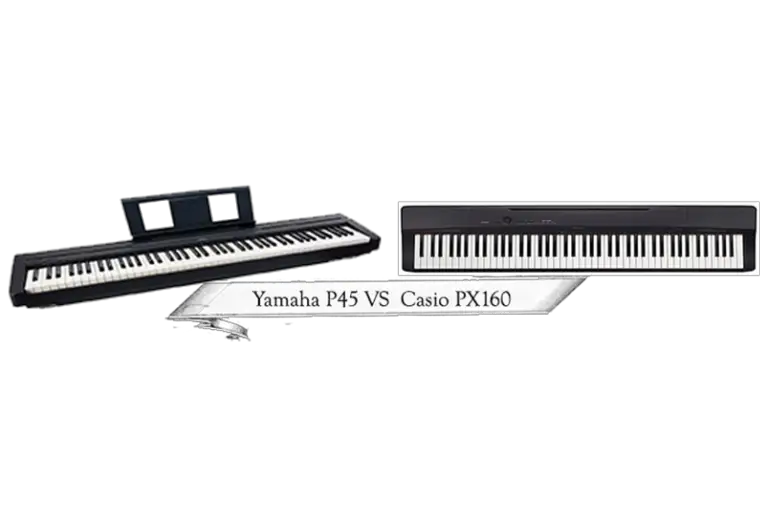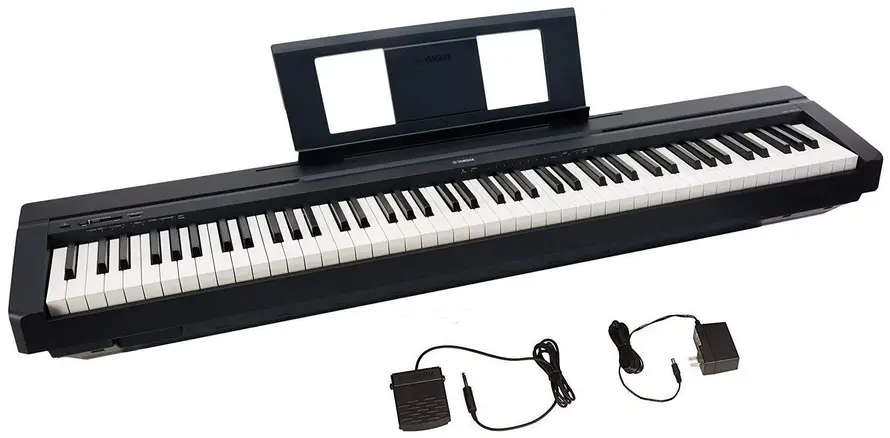Table of Contents
Introduction
If you want to look for an in-depth review and comparison on Yamaha P45 vs. Casio PX160, you’ve come to the right place. This article will explain to you the differences between the two keyboards in terms of specs and the like. We compare them side-by-side with various common aspects of a digital keyboard.
Number of Keys
The Yamaha 45 and the Casio PX160 both have 88 keys. This means that both of them can be used for higher octave songs like the classical ones and they can be used by all levels of skills when it comes down to playing the piano.
While the number of keys may not matter much to beginners, it can still be a great investment to go for a larger keyboard at first. This is because if you ever need to adjust and get a better keyboard next time since you have already mastered a couple of piano pieces, a much longer keyboard with 88 keys would be helpful.
If you also want to easily adjust from a keyboard to play a real grand piano that is not digital, having 88 keys beforehand can be a good experience for you when you practice. In this way, you will be able to use the extensive keys for whatever purpose you want, such as for classical songs or for creating music.
The winner in this round: both
Number of Tones or Voices
The Yamaha P45 has 10 voices. These voices range from keyboard or piano sounds up to some simple string sounds, which you can use for instant accompaniment. Strings can be used for church services or when you want to thicken your sounds overall.
On the other hand, the Casio PX160 has 18 voices. This also makes the price point higher (discussed later) than the price of the Yamaha P45. This lets you choose more effects for the keyboard other than the plain sounds. It is important for making music or just using the keyboard for live performances as well.
 The winner in this round: Casio PX160
The winner in this round: Casio PX160
Keyboard Sensitivity
Both the Yamaha P45 and the Casio PX160 employ hammer grade standards for their weighted keys or the keyboard sensitivity. GHS or Graded Hammer Standard is a kind of technology that employs a similar mechanism to a mechanical grand piano, mimicking the softness and loudness of the notes.
Each note can produce the sensitivity like a real grand piano would sound like. And since both of these keyboards have 88 keys each, they can both act as training grounds for shifting from a digital keyboard to a grand piano.
The winner in this round: both
Price
The Yamaha P45 is slightly cheaper than the Casio PX 160, but you can check the prices on Amazon for both, just to be sure. They are, however, in the same price range of below $500 keyboards.
Having a good price range for the features is great since you know that you are paying for the best specs for a keyboard.
Cheaper keyboards are okay for beginners, but if you can afford a bit, it may be wiser to invest in a slightly pricier keyboard that is not too expensive but still packs a lot of great features, quality sounds and excellent durability overall. However, the endpoint is that, if one product is pricier, the other may be more economical if it already has other freebies and it is a complete set.
The winner in this round: Yamaha P45
MIDI Compatibility
Both the Yamaha P45 and the Casio PX160 are MIDI compatible keyboards.
MIDI compatibility means that your keyboard can be able to input notes to your computer in your DAW or digital audio workstation so that you can make music or a digital score from your piano keyboard.
This feature is greatly needed by musicians because it allows them to produce music easier, faster and more naturally when it comes down to coming up with fresh melodies, chord progressions and the like.
The winner in this round: both
Included Accessories
The Casio PX160 only has the keyboard, while all of the accessories are sold separately. This could be either a pro or a con since some people do prefer buying a keyboard separately from the accessories since they want accessories that are much better in terms of quality than those included in a beginner’s package.
Meanwhile, the Yamaha P45 comes with a sustain pedal and the power supply, as well as the sheet music holder on top. This can appeal most to beginners who don’t have a sustain pedal yet and want to experience using one on a keyboard.
Sustain pedals are great to have on a keyboard because it allows you to mimic the sustain effect or pedal that is built-in onto every grand piano out there. The sustained effect prolongs the sound that is made by the keyboard or piano to make a sort of chilling effect that lingers when you play the keyboard notes and chords. It cannot be done with keyboards that do not have a sustain pedal option.
Having more accessories with the gear can have an impact on its price. However, given the price range of the Yamaha P45, we think that it is much more economical than the Casio PX160 due to the included accessories from the Yamaha one.
The winner in this round: Yamaha P45
Conclusion
To conclude our article, we believe that our big winner would be the Yamaha P45. In terms of price and the accessories included, it has a great advantage over the Casio PX160, which only has the upper hand for its number of voices (18 in total versus 10 voices for the Yamaha P45).
While Yamaha is our big winner, it still depends on what you want to buy. If you’re a fan of Casio products then go for the PX160. Otherwise, if you’re a beginner and would like a free sustain pedal, go for the P45 from Yamaha instead. We hope this mini-guide helped you in choosing which of these two keyboards would be the best for you!



